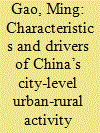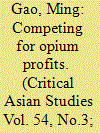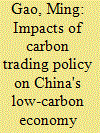| Srl | Item |
| 1 |
ID:
191356


|
|
|
|
|
| Summary/Abstract |
Identifying cities’ characteristics of urban-rural overall carbon intensity imbalance is significant for the formulation and implementation of emission mitigation policies. However, existing literature focused more attention on residential sectors, ignoring other important activity sectors’ emissions. Thus, this paper estimated China’s city-level urban and rural overall carbon intensities based on all activity sectors defined by EDGAR. Subsequently, we discussed the drivers from the perspective of urban expansion. The results show that (1) China’s activity sectors in rural areas presented higher carbon intensity than those in urban areas during urban land expansion, which was mainly caused by higher rural carbon emissions density and worse rural technological level; (2) Among cities, rural areas in some developed mega cities (e.g., Shanghai and Beijing) achieved lower carbon intensity than urban areas, while those in many developing cities still suffered from worse low-carbon economy. Carbon emissions density and technological gap were typically responsible for the worse situations of those developing cities’ rural areas; (3) based on impulse responses, an increase in urban-rural technology gap significantly reduced rural areas’ carbon intensity and urban-rural carbon intensity gap in lagged periods. Especially, China’s eastern region’s urban-rural technology gap made significant contributions to improving rural technological level.
|
|
|
|
|
|
|
|
|
|
|
|
|
|
|
|
| 2 |
ID:
188580


|
|
|
|
|
| Summary/Abstract |
This paper highlights the lives of Japanese and Korean subjects of Imperial Japan who were involved in opium production and circulation in Manchukuo. It discusses the dynamics, practices, and experiences of opium production and circulation. This paper provides a new reading of the diverse beneficiaries on the ground and of the opium industry in Manchukuo from the angles of production and circulation. Even as authorities continued to make significant revenue from the opium trade, the opium industry provided opportunities for diverse actors to profit from taking part in the state opium monopoly scheme. The interplay of these actors eroded Japanese imperial control over the new state. By dissecting the entanglement of the complex nature of the opium industry within a regional context, the paper demonstrates how the state actors were compelled to take action to combat illegal opium growing and selling.
|
|
|
|
|
|
|
|
|
|
|
|
|
|
|
|
| 3 |
ID:
191274


|
|
|
|
|
| Summary/Abstract |
Under the background of “carbon peak” and “carbon neutrality”, the important role of Carbon Trading Policy (CTP) played in China's micro-level low-carbon economy cannot be ignored. However, discussions on the CTP's impacts on China's county-level low-carbon economic quality are insufficient due to limited data availability. Hence, this paper estimated the quality of China's county-level quality of low-carbon economy based on satellite data during 2006–2018. In particular, the quality of low-carbon economy was evaluated by the ratio of low-carbon GDP to real GDP, which considers forest carbon sinks, CO2 emissions and real gross domestic product revised by the nighttime light data. Subsequently, this study examined how CTP affected China's county-level low-carbon economy using difference-in-difference-in difference (DDD) method. The results show that (1) CTP significantly improved the quality of low-carbon economy in county-level regions with high proportion of high-emissions energy consumption or secondary industry's output; (2) mechanism analysis shows that administrative intervention currently promoted the quality of low-carbon economy, while the market mechanism had lagged and positive effects; and (3) the ratio of forest land cover to total land cover and technological progress were also significant channels for CTP to improve the quality of low-carbon economy.
|
|
|
|
|
|
|
|
|
|
|
|
|
|
|
|